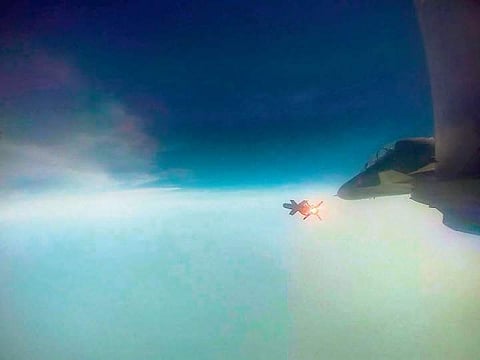

BHUBANESWAR:After two consecutive days of air exercise, Indian Air Force (IAF) on Wednesday successfully test-fired Beyond Visual Range Air-to-air Missile (BVRAM) Astra from a Sukhoi-30 MKI fighter aircraft over Bay of Bengal.
The flight test assumes significance as it was part of final pre-induction trials and the first of a six-round series. The world class missile is expected to be inducted in the IAF soon. Defence sources said the indigenously developed missile carrying telemetry equipment was fired from Sukhoi-30 MKI that took off from Kalaikunda air force station. The missile successfully engaged a manoeuvring target with high precision. “Astra was launched in complete Sukhoi-30 flight envelope. The missile targeted unmanned aerial vehicle Banshi and met all mission objectives,” said a defence official.
Once the futuristic weapon is made operational, India will become a member of an elite club of countries including the US, Russia, France and Israel that have the fast moving air-to-air missiles in their arsenal. “The test was perfect in all respects. Five more tests will follow to validate that the missile is ready to be inducted into the armed forces,” the official said, adding Astra has proved its capability as a formidable weapon. The missile has a strike range of 20 km to 80 km in tail-chase and head-on mode respectively. The complex missile can intercept fast-moving aerial targets at supersonic speed of Mach 1.2 to 1.4.
The 3.8 metre long single-stage, smokeless, solid propelled missile is one of the smallest to have been developed by DRDO as far as size and weight is concerned. It is more complex than nuclear-capable Agni series of strategic ballistic missiles in terms of technology. The missile has so far completed 20 developmental ground trials, captive flight tests and user associate launches from different locations and different weather conditions.
The missile was initially planned to arm Jaguar and Mig-29 aircraft but DRDO has integrated it with IAF’s front line fighter aircraft like Sukhoi-30 MKI and work is on to fit it in light combat aircraft Tejas.Defence Minister Nirmala Sitharaman lauded the efforts of IAF, DRDO and associated team members involved in the mission. She said India has attained a high level of capability in the indigenous design and development of advanced weapon systems.